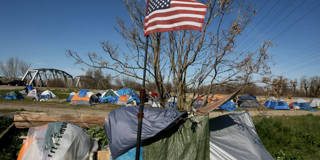Despite strong GDP growth and an extraordinarily low unemployment rate, more than a half-million people in the United States are homeless on any given night. And with housing prices rising while median wages remain stagnant, the problem will get worse unless policymakers intervene.
BERKELEY – After 95 consecutive months of job growth, the United States unemployment rate has fallen to 3.7%, its lowest point since 1969. Yet wage growth remains stubbornly slow. In fact, after adjusting for inflation, the median weekly earnings of full-time workers are about the same as they were in 1979. In a related indicator of stress on American workers, the number of homeless people in the US actually rose in 2017 – the first increase since 2010 – partly driven by skyrocketing rents and housing prices.

BERKELEY – After 95 consecutive months of job growth, the United States unemployment rate has fallen to 3.7%, its lowest point since 1969. Yet wage growth remains stubbornly slow. In fact, after adjusting for inflation, the median weekly earnings of full-time workers are about the same as they were in 1979. In a related indicator of stress on American workers, the number of homeless people in the US actually rose in 2017 – the first increase since 2010 – partly driven by skyrocketing rents and housing prices.